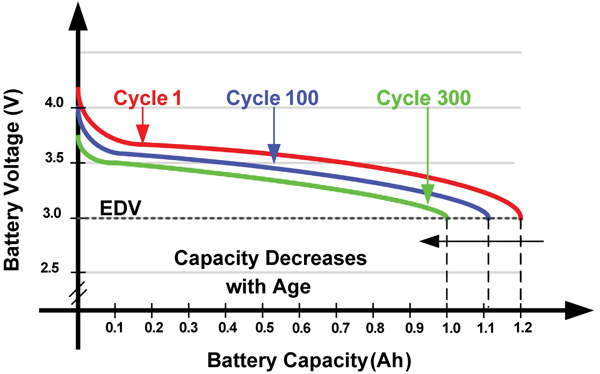Apple Confirms CPU Limitation In Ageing Devices
by Andrei Frumusanu on December 21, 2017 7:18 AM EST- Posted in
- Mobile
- Apple
- Smartphones

Over the last week there's been increasing discussion and evidence of Apple's supposed introduction of CPU throttling mechanisms directly related to the battery wear level on Apple iPhones. The story started out with a report on Reddit of a user experiencing slow performance on an iPhone 6S and subsequent discovery that the performance restored to its full potential after a battery replacement.


Graph credit: John Poole, GeekBench 4 Blog
The report prompted GeekBench author John Poole to make use of the GeekBench benchmark submission database to plot performance of individual devices against iOS versions and discover a clear trend of ever increasing distribution towards lower performance points with newer OS versions.
Matthew Panzarino from TechCrunch was able to get an official statement from Apple when enquiring about the problem:
Our goal is to deliver the best experience for customers, which includes overall performance and prolonging the life of their devices. Lithium-ion batteries become less capable of supplying peak current demands when in cold conditions, have a low battery charge or as they age over time, which can result in the device unexpectedly shutting down to protect its electronic components.
Last year we released a feature for iPhone 6, iPhone 6s and iPhone SE to smooth out the instantaneous peaks only when needed to prevent the device from unexpectedly shutting down during these conditions. We’ve now extended that feature to iPhone 7 with iOS 11.2, and plan to add support for other products in the future.
Apple’s official statement sheds some light into the issue but comes short of an actual technical explanation of why the power management is failing. The company claims that the issue at heart is because of the battery degradation and its inability to supply sufficient current at a stable voltage.

Graph credit: Electronic Component News
Capacity and supply voltage of a battery decreases over time as a function of charge cycles and charging behaviour (Higher charging currents causing more degradation per cycle). This causes the total useable battery capacity before the cut-off voltage to decrease.
The problem facing the iPhones as Apple explains it is however two-fold; the issue at hand happens only during load spikes in which the battery isn’t able to maintain a high enough voltage for the PMIC to reliably be able to use as a source.

Graph credit: Electronic Component News
SoC blocks such as CPUs and GPUs can have very short transitions from idle to load causing steep transients and load spikes going above the +10W ranges. As batteries degrade over time and the cell impedance also rises also in function of the state of charge and temperature, the current flow becomes restricted and the cell is no longer able to satisfy the power requirement at a high enough operating voltage.
Apple’s approach to the issue is to limit the peak power spikes by reducing the CPU frequencies over time as a function of battery wear. This solution however raises several questions; how does Apple decide the throttling behaviour and was the core fault an engineering fault or design choice?
As demonstrated in John Poole’s dataset Apple is throttling the CPU frequency in several stages. What exactly defines the thresholds to reach these stages can be either a rather simplistic counter taking into account the charge cycles of a given battery, or (and more hopefully) a more dynamic method that would be able to take advantage of the battery PMIC’s capabilities of determining battery wear. Given however that it seems that the OS is limiting performance even at high state of charges, such as fully charges batteries, it seems that the limitation implementation is unfortunately of the more simplistic type.
The second question comes to regard to as why it came to the issue in the first place as this should be a universal issue affecting a greater number of smartphones, not just Apple iPhones.
The first unique characteristic separating Apple iPhones from other smartphones is that Apple is using a custom CPU architecture that differs a lot from those of other vendors. It’s plausible that the architecture is able to power down and power up in a much more aggressive fashion compared to other designs and as such has stricter power regulation demands. If this is the case then another question rises is if this is indeed just a transient load issue why the power delivery system was not designed sufficiently robust enough to cope with such loads at more advanced levels of battery wear? While cold temperature and advanced battery wear are understandable conditions under which a device might not be able to sustain its normal operating conditions, the state of charge of a battery under otherwise normal conditions should be taken into account during the design of a device (Battery, SoC, PMIC, decoupling capacitors) and its operating tolerances.
If the assumptions above hold true then logically the issue would also be more prevalent in the smaller iPhone as opposed to the iPhone Plus models as the latter’s larger battery capacity would allow for greater discharge rates at a given stable voltage. This explanation might also be one of many factors as to why flagship Android and other devices don’t seem to exhibit this issue, as they come with much larger battery cells.
While much of the latter part of this piece is just my personal conjecture as to the deeper causes of the problem, it is clear that this is a larger issue for Apple that has no simple solution (beyond replacing the battery). How this affects more recent devices such as the iPhone 8 and iPhone X, or verifying if indeed the Plus variants would be less prone to the problem is something that will require a lot of testing, collaboration and data collection over longer periods of time.










122 Comments
View All Comments
Dragonstongue - Thursday, December 21, 2017 - link
is funny seeing as Apple tends to be near or the most expensive phones in their class and tend to also offer the lowest capacity batteries for them, they cannot use excuse of because they are thinner or whatever, cause many different Android models are just as thin (or thinner) yet offer higher capacity on a similar or higher spec phone.They seem to do "ok" for the battery capacity so they are well designed, but, when they want a higher $ premium, they should IMO also be offering a better experience, a simple change, user replaceable battery, and a default higher capacity battery so instead of the seemingly normal Apple way of what ~1400Mah batteries, they should be doing in the 2800+ range (I know some models are of decent size, but, it is not a "space constraint" thing, others offer quite large batteries in comparison..LG X power 2 4500Mah battery compared to say Iphone 8 Plus "rated" 2691, so the XP2 is a 59.8% larger capacity)
Anyways, all phone makers need to think twice about specs, one of these things have to be a larger battery and enough thickness to hold up to at least some abuse ^.^
Jon Tseng - Friday, December 22, 2017 - link
Bear in mind user replaceable battery also means thicker device or less battery capacity. Apple decided that actually represents a worse user experience. Of course if you disagree you can just shop elsewhere - I would recommend a Xiaomi Redmi 4000mah FTW.maxijazz - Tuesday, December 26, 2017 - link
Apple should use twice bigger batteries. Side-effect would be camera bump-up disappear. I don't think anyone would complain about 2mm increased thickness. That would be excellent customer experience. But it would significantly reduce Apple's margins.jjj - Thursday, December 21, 2017 - link
Apple should sell imaginary products, both Apple and their customers would be better off that way.FunBunny2 - Thursday, December 21, 2017 - link
what was it that Gates said when each iteration of Windoze trashed existing machines? "Let the hardware fix it." back in those days CPU performance was moving from the blade of the hockey stick to the shaft, if you get the analogy. these days, SoC performance is on the flattening top of that common lazy S-curve you've all seen. and, of course, the bigger issue is that battery performance has never been on the shaft of its hockey stick.so, the obvious answer is that Apple is bloating phoneOS just the way Gates did to Windoze to drive hardware sales. in Gates case, he only got come of the candy. Jobs/Cook get it all.
philehidiot - Thursday, December 21, 2017 - link
To me, this works along the same lines as the S8 being so pretty but so fragile. It's only going to impress reviewers as everyone else has to buy a case to stop it shattering and as a result is denied the benefit of all the "oh it's so nice to hold" and "ooh pretty glass". This is clearly a design choice. You don't make a phone with a battery that you know behaves like this (you're gonna test its endurance to ensure it's suitable) and then not know that your peak draw exceeds what an ageing battery can pump out.This is a choice to give the excellent single threaded chooch factor for reviewers and people who are raving about their new phones whilst the battery is capable but in the knowledge that this will quickly diminish over time and that the peak power draw will have to come down. You could argue that a car that starts off with 100 bhp and will lose some of this over time as part of wear and tear but that would be bollocks. You design the car with wear and entropy in mind to ensure that it will perform adequately for its expected life. This is akin to gaming the benchmarks in my book because they know this performance isn't sustainable and that performance which is seen by reviewers is not representative of what you'll get down the line. It's a little bit like sticking an i5 in the older (circa 2011) MacBook airs which performs amazingly for a few minutes and then shits itself with the heat and throttles to the point where youtube is a challenge too far. I'm sure benchmarks were in the mind of the people who made that design choice. Oh, no.
When this is part of the technology, such as an empty Vs full SSD it can be tested for and forgiven. In this case it is a design choice which has been hidden from customers. I wonder how many thousands / millions have upgraded their iPhone to a new model when a battery replacement for a tenth of the cost would have sufficed? This is another nail in the Apple shaped coffin for me (actually, it's a bloody axe). I bought a MacBook Air a while back and, whilst I'm exceedingly happy with the product itself, when the charger broke the customer service was utterly shit. Smelly dogshit shit. I had "Apple Care," was treated like scum in their store (having very recently dropped over a grand in there, they should have been licking my feet knowing I had money and was possibly going to spend it there) and then looked at reviews of their chargers (which cost £60!) which showed that failure was practically guaranteed after around 18 months. Just after the 12 month warranty runs out. Funny that. I bought a cheap generic one and it's still going 4 years on. I can not abide treating your customers in this manner. The MacBook now has Linux on. It's better this way. There are now Windows laptops which fulfil my criteria (at the time there was only the Air) and so I won't be needing to "invest" in a "we're so superior" Apple cult product again.
Now, where can I get a Tesla?
jsntech - Thursday, December 21, 2017 - link
Does this only affect iPhones or does it also apply to iPads?Total Meltdowner - Thursday, December 21, 2017 - link
Samsung Galaxy S6 ACTIVE owner here. The battery in this this is freaking amazing. I've had the device since it was released and it lasts a solid 24 hours under use. Granted, I always have bluetooth and gps tracker off (unless I need).I can take this phone apart and replace the battery as well. Really love this phone. I wish these companies made more durable phones with replaceable batteries.
ads295 - Thursday, December 21, 2017 - link
The Active series is the best variant of the Galaxy Sx. Unfortunately no one outside the US gets to see them. I'd probably buy an S7 Active and keep it for a decade - last flagship with a half-decent screen size.rocky12345 - Thursday, December 21, 2017 - link
So is this what Apple would call a feature then..lol They make it like they are trying to protect you from sudden shut downs when the real truth is they want you to upgrade to a new phone. I guess they figure if you get upset enough with your old phone acting like it is getting slow you will just walk into a Apple store or a provider and upgrade to a new and improved iPhone that will be fast fast fast.I still am on a Samsung Galaxy S5 & have never changed the battery it is over three years old. It has never shut down do to cold or got slower IT JUST WORKS as it should. I still charge it once every 4-5 days like I did when it was new.
So either Apples design is bad or their batteries are weak to begin with take your pick. It could be just pre planned to make you have to upgrade every couple of years even though your phone would have been just fine if they did not mess with the power & performance levels.